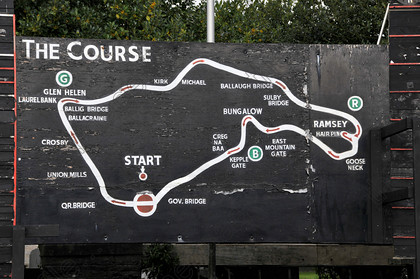Vintage British Motorcycles
Article by Mark Trotta
British motorcycle history goes back to 1896 with the Excelsior Motor Company. Other early motorcycle companies from England include Royal Enfield (1901), Norton (1902), Triumph (1902), and BSA (1910).
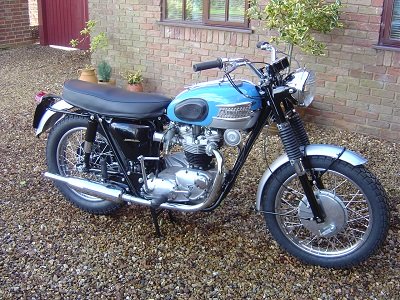
Early Norton Motorcycles
James L. Norton began building motorized bicycles in 1902, followed by V-twin models, and then side-valve, OHV and OHC singles. Following World War II, Bert Hopwood engineered the first Norton twin, the 497cc Model 7. For 1960, Norton introduced an all-new engine 650cc twin, and soon after the larger-bored 750cc Atlas (produced 1962 through 1968).
Triumph Parallel Twin
Designed by Edward Turner, the two-cylinder Triumph "Speed Twin" was introduced in 1937. The 500cc parallel twin developed 27-horsepower, making bikes capable of 90 mph. Engine displacement increased to 650cc in 1950.
The parallel-twin design was an instant success, and would prove to be the definitive British bike engine.
Early Triumph Speed Twins featured girder front forks with no rear suspension. By 1946, telescopic forks were standard equipment, with sprung-hub rear suspension optional.
_______________________________________________________
_______________________________________________________
WW2 Motorcycles
Powered by a 496cc single-cylinder engine, the BSA M20 was the most-produced motorcycle of World War II. During a German bomb raid in November 1940, the BSA factory in Small Heath, Birmingham was targeted, killing 53 workers with 89 more injured. Production was transferred elsewhere and production of the M20 continued.
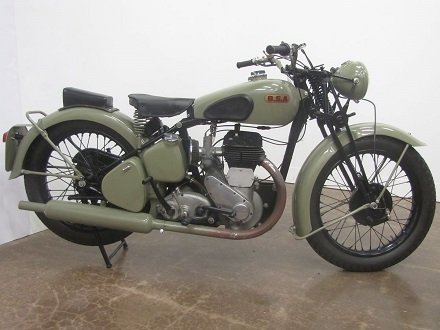
Picture Courtesy National Motorcycle Museum, Anamosa, Iowa
During the War Years, BSA built 126,000 M20 motorcycles.
Between 1937 and 1945, Norton manufactured nearly 100,000 motorcycles for the British military, allowing the company to endure the war.
The original factory of the Triumph Cycle Company Ltd. was located in Coventry, England, until WW2 bombing destroyed it in 1940. After the war, the company began producing motorcycles in Meriden, England, and would continue to do so until 1983.
**********************
Triumph Engineering Co Ltd
Not only was Triumph the sales leader among British motorcycle brands, they often led the way in performance as well. After 1950, more Triumphs would be sold in the USA than in any other country, including Britain. To better serve U.S. markets, Triumph set up a distributing company in Maryland in 1951.
BSA/Triumph Merge
The BSA (Birmingham Small Arms Company) Group purchased Triumph Motorcycles in 1951 and become the largest producer of motorcycles in the world at that time. During the fifties and sixties, the motorcycle industry was Britain's third largest market.
Triumph Thunderbird 6T (1949-1966)
Featuring a 649cc overhead valve parallel-twin, the Thunderbird 6T boasted a top speed of 100 mph (161 kph). Visual standouts included a tear-shaped gas tank, chrome accents and dual exhaust.
Triumph Tiger Cub
Also designed by Edward Turner, the 200cc single-cylinder Triumph Tiger Cub debuted in November 1953. The first version of the Cub (1954-1956) had a plunger rear suspension frame. Later models (1957-1968) were updated with a rear swing-arm
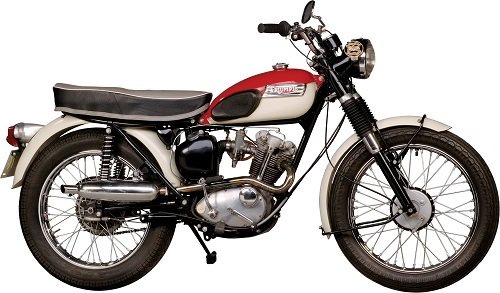
In 1961, driving license regulations in Great Britain changed. By restricting learner motorcyclists to a maximum of 250cc, the Tiger Cub became one of the best selling small bikes.
Triumph Scooters
During the fifties and sixties, Triumph and BSA also sold motor scooters. The Triumph Tigress scooter was also sold as the BSA Sunbeam. Differences between the two were purely cosmetic.
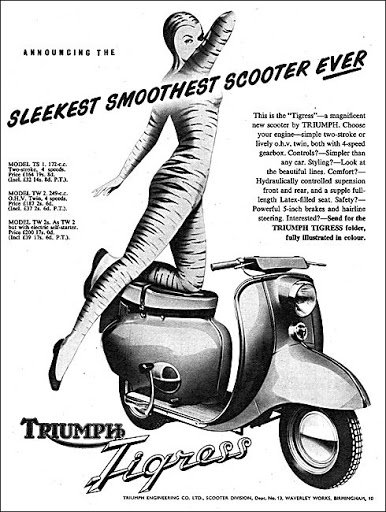
**********************
BSA
The Birmingham Small Arms company began manufacturing guns in 1861. After making bicycles for several years, motorcycle production started in 1910.
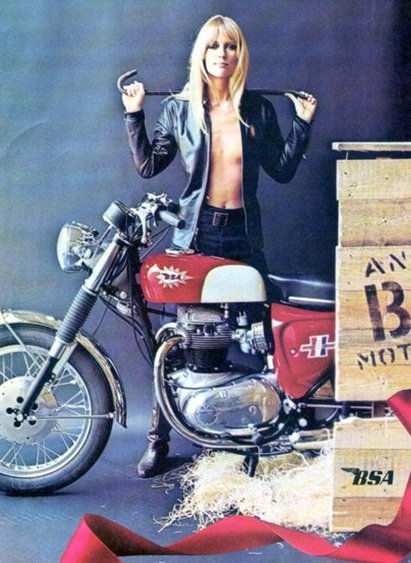
Several of their bigger models were the A10 Super Rocket (1958-1963), A10 Rocket Gold Star (1962-1963), A65 (1964 - 1972), and the three-cylinder Rocket lll (1969-1972).

Pictured: A10 in custom hardtail frame.
BSA Lightning
Produced from 1965 through 1972, the Lightning featured a 654cc vertical-twin engine with high-lift camshaft, and a close-ratio gearbox.
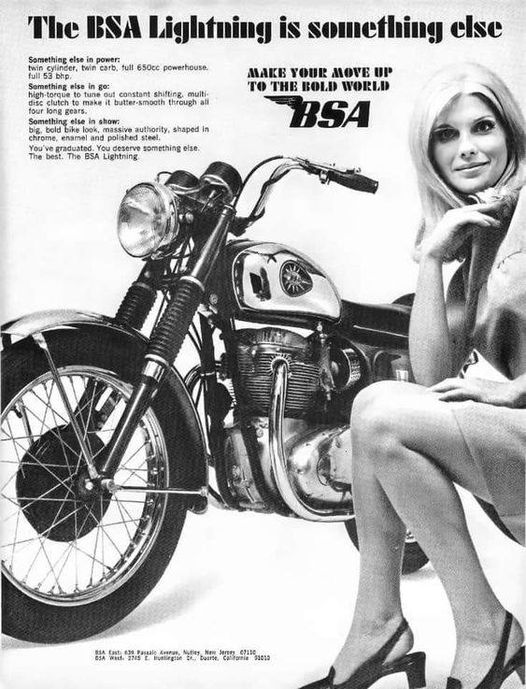
In the 1965 James Bond film Thunderball, Italian actress Luciana Paluzzi is seen riding an RPG-equipped BSA Lightning motorcycle.
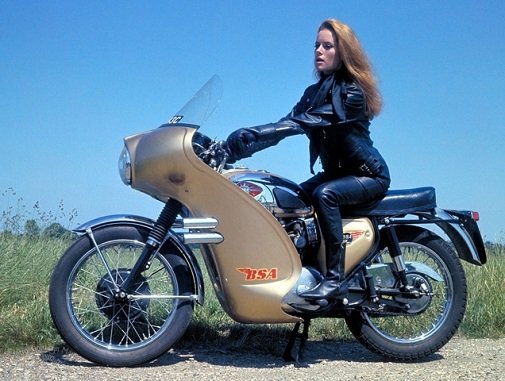
During actual filming, the bike was actually ridden by UK motorcycle champion Bill Ivy wearing a blonde wig!
**********************
Throughout the 1940's and 1950's, British bikes dominated motorcycle performance and racing venues on both sides of the Atlantic.
**********************
World's Fastest Motorcycle
Running on a mixture of 80 percent methanol and 20 percent nitro methane, U.S. native Johnny Allen set a new motorcycle speed record of 214.40 mph at the Bonneville Salt Flats in 1956. His 15-foot-long streamliner was powered by a heavily modified Triumph 650, fed through twin 1-3/8" Amal GP carburetors, and producing between 80-100 horsepower.
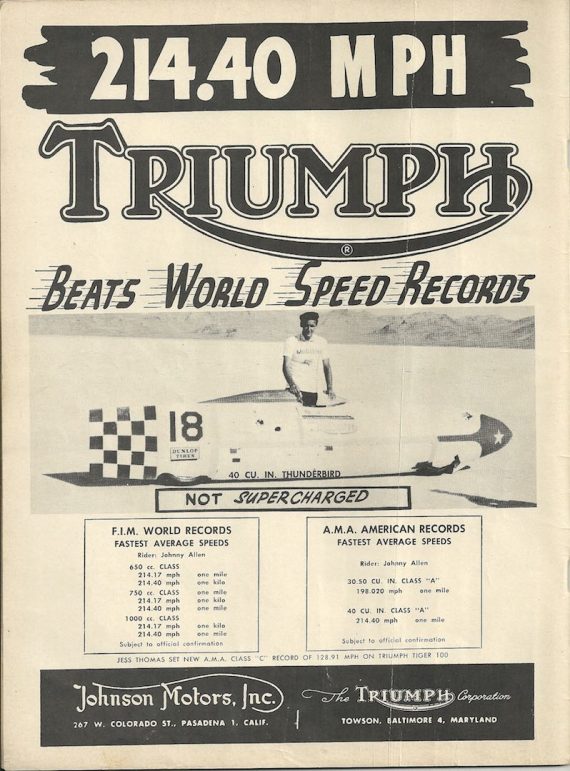
Triumph held the title of "World's Fastest Motorcycle" from 1955 to 1970.
**********************
Triumph Bonneville
The original Triumph Bonneville motorcycles were built from 1959 to 1983. Manufactured in three generations over three separate production runs, it is the best-selling British-twin of all time.
Read: Triumph Bonneville History
Three-Cylinder Models
The multi-cylinder motorcycle years started in 1968 with the three-cylinder Triumph Trident, along with it's "cousin" the BSA Rocket III.
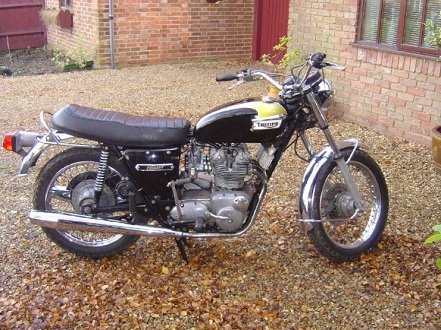
Read: 1974 Triumph Trident Restoration
Soon after, Japanese manufacturers were producing faster, cheaper, and more reliable motorcycles, severely cutting into the sales of both British and American-made bikes.
**********************
"The Wild One" Movie
The 1953 movie "The Wild One" starred Marlon Brando riding a 1950 Triumph Thunderbird 6T.
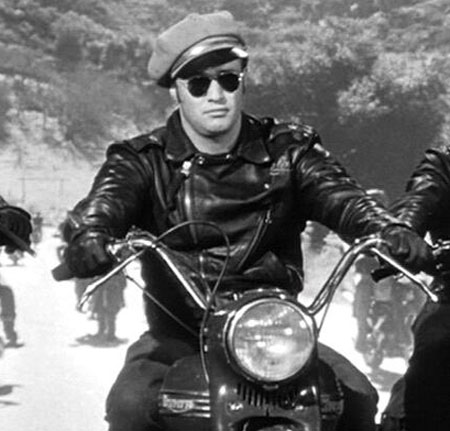
The movie also featured actor Lee Marvin riding a Harley-Davidson Panhead.
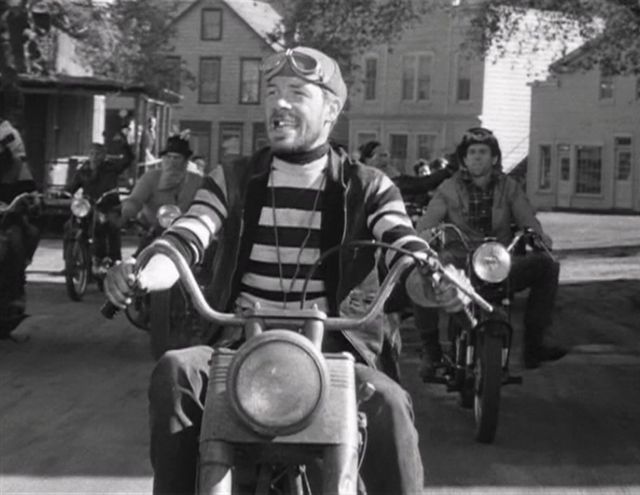
Because of its brutality and sadism (for the time), the film was banned by the British Board of Film Censors until 1967. Many Triumph importers objected to the use of Triumph motorcycles in the film.
Although loosely based on a real events, the movie was mostly fictitious.
**********************
Norton Commando
Utilizing their existing Atlas engine with a new frame, Norton began production of the 750cc Commando in 1968. Until the demise of the original company in 1977, the Commando was the main bike in Norton's lineup.
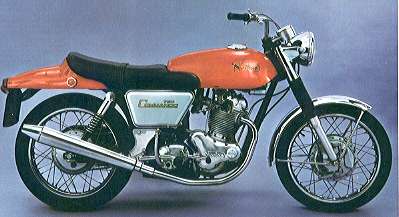
Read: Norton Commando History
Along with several notable upgrades, an increase of displacement to 828cc was seen for 1974 models, and 1977 (which were actually 1976 leftovers) would be the last of the original Norton parallel-twin machines.
**********************
In addition to the 'big three' British manufacturers, there was AJS, Ariel, Douglas, Matchless, Excelsior, Brough Superior, Velocette, Vincent, Ariel, and Royal Enfield.
Douglas
Douglas produced motorcycles from 1907 and 1957. During the 1920's, they enjoyed many race wins at the Isle of Man.
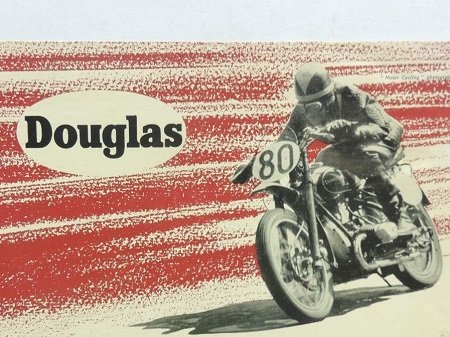
Aside from it's single and parallel twin models, Douglas also produced a series of flat-twins.
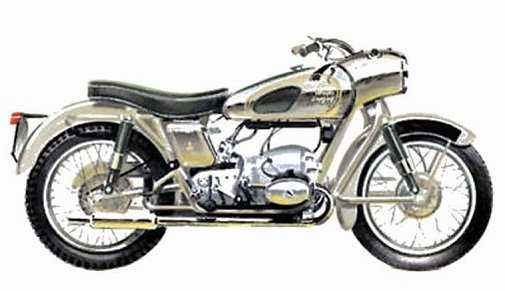
Douglas motorcycles were never widely imported into America. The reason for this was likely their smaller displacement engines.
**********************
Vincent Black Shadow
Produced from 1948 to 1955, the Vincent Black Shadow was the super-bike of its day. Each and every one was hand-built and used the highest quality materials.
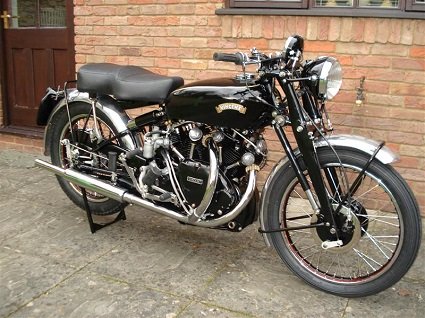
Fewer than 1,700 Black Shadows were produced.
**********************
Norton Villiers Triumph Merger
By 1971, the original Triumph company suffered terrible financial losses. With their government intervening, they merged with ailing Norton, who had recently merged with Villiers. The new company, calling themselves Norton-Villiers-Triumph (NVT), carried on for several more years, but was never able to rebound.
By 1976, both Triumph and BSA were out of business. Triumph motorcycles would go back into production in 1983.
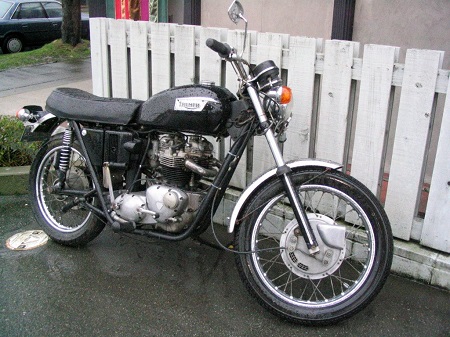
**********************
U.S. Import Tariff
The year 1982 saw Harley-Davidson motorcycle sales at an all-time low. In order to help them and American economy, U.S. President Ronald Reagan imposed a 45% tax on imported motorcycles, While this was primarily done to slow down Japanese motorcycle sales, it severely hurt British and European bikes.
The tariff was reduced to 35% in 1984, and then 10% in 1987.
**********************
Norton Resurgence
In 1978, Dennis Poore acquired the remaining assets to form Norton Motors Ltd. Once back in business, they began building small numbers of rotary-powered Interpol 2 motorcycles to British police forces. After Poore died in 1987, Phillipe LeRoux acquired Norton and formed the Norton Group PLC.
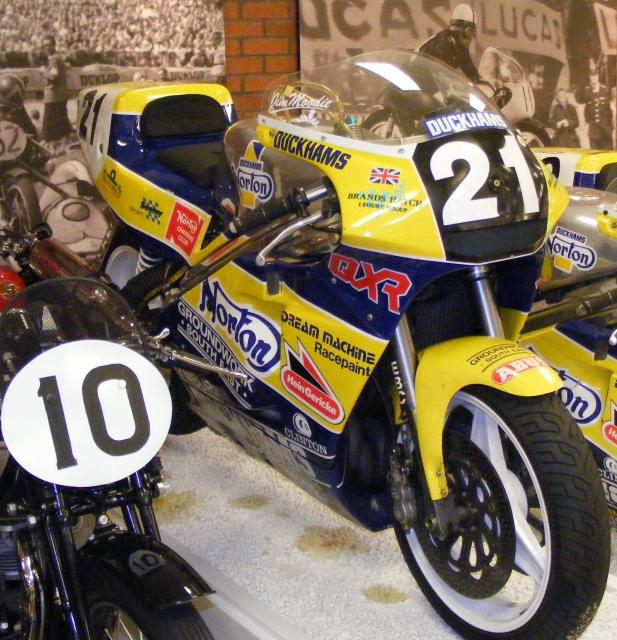
Produced through the 1989 to 1994 racing seasons, the Norton RCW588 racing motorcycle was powered by a liquid-cooled twin-rotor Wankel engine. The capacity of 588cc was to comply with FIM rules, allowing Norton to enter the 500 Grand Prix premier racing class in 1990.
For about a decade, Norton produced very few (less than 1,000) rotary-powered motorcycles. The Norton F1 is the street version of the RCW588 race bike.
By 1992, with the company over $12 million in debt, Norton was once again out of business.
_______________________________________________________
_______________________________________________________
Future Classic
The Steve McQueen Triumph is inspired by the Triumph Trophy TR6 from "The Great Escape" movie, and features a military-style Matte Khaki-Green finish, stencil-style Triumph decal on the tank and the actor's signature on the side covers.
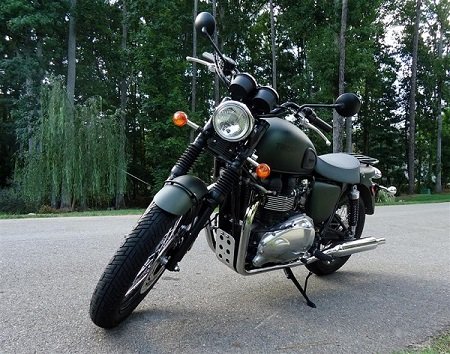
Beginning in April of 2012, 1,100 Steve McQueen Special Edition Triumphs were produced and sold worldwide. Each motorcycle is individually numbered with a plaque placed on the handlebar clamp, with owners receiving a certificate of authenticity.
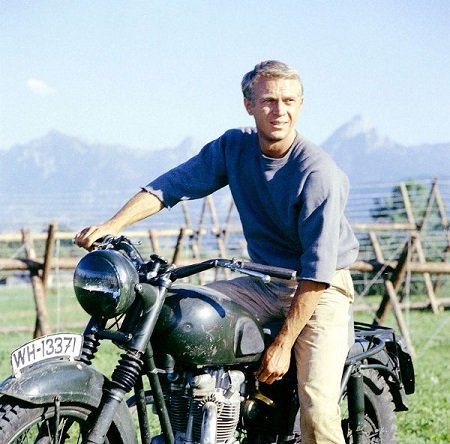
Steve McQueen in 1963 movie "The Great Escape"
**********************
Articles Of Interest:
Triumph Bonneville History
Triumph Trident History
Norton Commando History
Kick-Starting An Old Motorcycle
What Are Whitworth Tools
